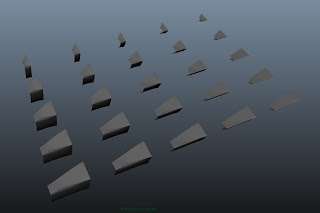Exploration 1
The end product in the far corner, as expected, became short and collapsed, yet still somewhat reminiscent of the original nurbs surface. In the second exploration...
Exploration 2
In this study, the matrix starts with the original shape in the top left. Moving in the X plane, I offset the NURBS surface. I would then take that newly created offset surface and offset it again and again. Each time, this yielded a much more complex and amorphous surface. In the Y direction, I simply sheared the X plane by 0.4.
This study yielded a FAR different product once the matrix study ran it's course. In contrast to the first matrix study, this one seemed to really explore how quickly a surface can change through a prescribed set of variables.
Lessons Learned
Often in studio environments, form of a building is something we struggle with. Those unfamiliar with "blob" geometries and studies tend to rely on a limited set of forms and rules. Often time, we seek to precedent studies and tend to try to morph those buildings. Perhaps, through studies like these, we can take precedents we find and enter them into a matrix of form studies. Altering specific things in the building formally or functionally in a controlled setting can allow for documented studies as well as an alternative approach to design methods.
Now, if only I could figure out this Maya program... Back to the virtual drawing board.
TME




Beginning with such a simple shape led to such a dramatic transformation. I think this could be very useful in design because it enables a broad language within one system.
ReplyDeleteThis comment has been removed by the author.
DeleteI found your idea of applying this to precedent studies interesting. It could prove to be a useful tool, permitting morphologies rather than mimickries of the original building(s).
ReplyDeleteWith regards to Exploration 2, it would be intriguing to see what type of surface | form could be generated after another 25 iterations since it changed so much in this study without becoming overly complex.